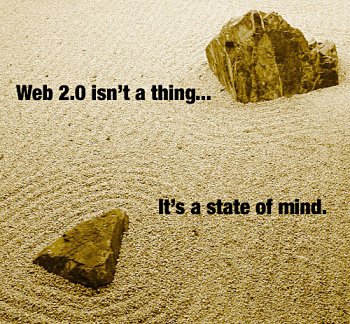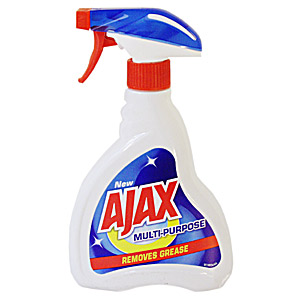
Easy. Just read the official definition by Tim O’Reilly.
In a nutshell (and as presented beautifully by Andy Budd and from where I got this beautiful photo), Web 2.0 is not a new technology or a new framework. Rather Web 2.0 is a new way to think of web applications.
Principle #1: The Web as a Platform
Web 1.0 was a collection of static HTML files. Web 2.0 is full of computer-generated dynamic pages which are available using web services technologies such as SOAP and REST.
More pragmatically, in Web 2.0, every single item of information can be requested (if that information is public of course) using either a function call or by GETting a URL.
Personally, I find the REST model the way of the future and, for example, Google has deprecated SOAP.
Principle #2: Harnessing Collective Intelligence
Web 2.0 is based on open standards and encourage people to contribute their personal data. Based on the contribution of thousands of people, Web 2.0 websites derive extremely valuable information that cannot be guessed (or calculated) otherwise.
One example is Last.fm. Each time someone listens to a MP3, a small bit of data is sent to this application (if the person has installed the required software of course). After some time, Last.fm can build detailed statistics about the popularity of artists.
What’s extremely cool about Last.fm is that it also correlates users i.e. it tells me who listens to music similar to what I like. And, through this network of “friends”, I can discover new music.
Another notable example is Wikipedia which has become, through contributions by normal persons, one of the best sources of information on the web. I use Wikipedia daily to prepare my University lectures :-)
To summarize, Web 2.0 applications use contributions from users to derive collective knowledge which is openly available.
Principle #3: Rich User Experience

Web 2.0 applications work in a browser but feel like desktop applications. Examples are GMail and Flickr Organize.
Those are examples of AJAX applications.
Many Web 2.0 applications are being built using the Ruby on Rails framework which I’m currently learning. Of course, one can also use JavaScript which is an extremely powerful programming language.
I’ll write on AJAX in my next post.

and i believe all the students leavin uni and entering the job market need to have a knowledge of these
as for me, i’ve started with ajax..and soon will move to RoR..since in abt less than 1 month i will be kinda free
most of uom students have already covered js and xml, now they should learn to use both
Dear Mr Meetoo,
It’s a great pleasure and a source of satisfaction and pride to see a blog initiated/managed by a compatriot. You are a trend setter. Your blog was actually relayed to me by Google News. This means that you write-up has reached a truly world-wide audience. I sometimes write in Mauritius Times, providing observations on the teaching and speaking of English in the country. It was my hope that teachers would comment. I have never received a single message from Mauritius, even though I do receive some from overseas. I earnestly hope others will follow your example.
Keep it up. Best Regards – Parmanund Soobarah
I personally believe last week’s famous revolt of Digg users was some sort of a milestone for the new Web. It clearly demonstrated the extent to which things are now dictated by user contribution. It was simply amazing to see the way people around the world retaliated to the site’s blocking of the first story about the HD-DVD key code.
To Sundeep:
Yes, you are 100% correct. All students should know (at least the basics) of AJAX and Web 2.0 because, after all, this is the current (and next) BIG THING in software development.
To Paramund (you can call me Avinash…):
Thanks for pointing out that Google News is relaying what I write. It’s nice to know. In fact (and this is something I always tell my students), if you do something with passion, such rewards always come after some time.
Don’t worry. I’ll read your articles in Mauritius Times more attentively now ;-)
To Fadil:
Yes. Only those who are truly open will survive the Web 2.0 revolution.
In fact, I am starting to believe that, we, bloggers, are slowly becoming a political force (in the sense of “politics is the process by which groups of people make decisions. It is the authoritative allocation of values.”)
@sundeep
i had a quick look at ajax too.. some autocomplete scripts and basic suggest.. nice and while doing js i didn’t have a clue that all these could be done. well its definitely something i will return back to when i get some time..
@avinash
after paralell processing.. system software… MAD.. seems you are very much interested in the web..
i see a new module a l’horizon :P (web tech??)
Nah, here is the definition:
http://www.stephanelee.com/2006/02/23/definition-of-web20.html
To Vicks:
Perhaps. To be frank, I need to “streamline” what I teach. I’m still thinking about what I’ll drop and what new module I’ll take. And don’t forget that there are MSc modules too…
Hi Avinash
I completely agree with what you’ve said. In fact just this morning I was speaking to one of my friends about how applications will become mashups of external stuff using web services etc. As for the principle #1, Web as a platform, I usually use the term the “Browser as a platform”. And I believe that the browser has become more of a utility or call it an interface to download Rich clients such as Flex applications (http://www.flex.org) using HTTP and once the app goes in full screen mode you’re not even aware of the browser. Its unfortunate though that XUL didn’t get the popularity it deserved as I think XAML from Microsoft is nothing more than XUL under a new name.
With the open sourcing of Flex 2 by Adobe and Microsoft “attempting” to follow suit with Silverlight things are becomming intesting for developers.
One thing that would be interesting though is when WEB apps stop caching images or other data without the need for secure connection using
Now since lots of uni students read your blog I have just one piece of advice to them, or make it two.
1. Lose the arrogance that when you have a degree the next guy without one is no good. The best developer in my team doesn’t have a degree and he’s one of the best I’ve met so far.
2. When learning programming have the same approach as learning to drive. You don’t learn to drive a toyota or a bmw, you learn how to drive a car. So don’t “learn” Java or VB.NET or whatever, rather learn how to solve problems using a programming language and available tools.
Beautiful analogy Raj!
Bad drivers are afraid to drive family cars as they learned to drive in a small Toyota Starlet or a Nissan March.
Something I always say to my students:
“Lorsque le sage montre la lune du doigt, l’imbécile regarde le doigt…”
Nice article!!
Thanks!
Even though it was written more than four years ago, a lot of people still don’t understand what Web 2.0 means. I was at a conference the other day and one speaker was saying that Web 3.0 is coming to replace 2.0 and I couldn’t help myself thinking that he was speaking bullshit.
Web 2.0 is a philosophy. Web 3.0 is another one (based on the semantic web). Both philosophies can cohabit.
But, for now, Web 2.0 rules and all of us, professionals or students, should know its real meaning.
So much about Web 3.0. I’m just wondering what it’s gonna be like. Web 2.0 is basically the “social” Internet. Will Web 3.0 be mobile web? Or augmented reality? Or some new form of AI guys at MIT are currently working on in a secret lab?
Tim Berners Lee says that Web 3.0 is about the semantic web. Personally, I don’t really understand what he’s trying to achieve compared to what we currently have…